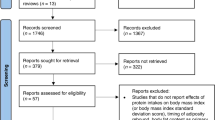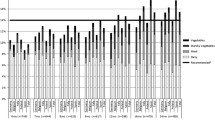Abstract
Protein deficiency results in retarded growth, and many studies from developing countries have shown that animal protein has a growth-promoting effect in children getting a diet mainly based on vegetable products. To what degree this is caused by an improved protein quality, nutrients associated with animal protein such as zinc, or a growth-stimulating effect of certain amino acids or peptides is not known. In industrialized countries, it is not likely that either the amount of protein or the protein quality will be growth limiting in healthy children. However, there are data suggesting that the high protein intake in infants and young children seen in industrialized countries could have growth-modulating effects and that there could be long-term effects. The aim of this paper is to review data on the association between early protein intake and linear growth velocity and early protein intake and later development of obesity. The review will focus on term healthy infants and young children from industrialized countries. The review will also include data on differences in growth and development of obesity between breastfed and formula-fed infants as there are considerable differences in protein intake between these two groups and one of the suggested causes for these effects has been difference in protein intake.
Zusammenfassung
Proteinmangel führt zu verzögertem Wachstum, und viele Studien aus Entwicklungsländern haben erwiesen, dass tierisches Protein eine wachstumsfördernde Wirkung auf Kinder hat, die hauptsächlich mit Gemüseprodukten ernährt werden. In welchem Ausmaß das durch eine bessere Qualität des Eiweißes, mit tierischem Protein einhergehende Nährstoffe wie Zink oder die wachstumsstimulierende Wirkung bestimmter Aminosäuren oder Peptide verursacht wird, ist nicht bekannt. In Industrieländern ist es unwahrscheinlich, dass die Proteinmenge oder die Proteinqualität den wachstumsbegrenzenden Faktor bei gesunden Kindern darstellt. Es gibt jedoch Hinweise darauf, dass die hohe Proteinzufuhr bei Säuglingen und Kleinkindern in Industrieländern eine wachstumsmodulierende Wirkung haben und Langzeitwirkungen bestehen könnten. Ziel des Beitrags ist die Darstellung von Daten zum Zusammenhang zwischen früher Proteinzufuhr und linearer Wachstumsgeschwindigkeit sowie zwischen früher Proteinzufuhr und späterer Entwicklung einer Adipositas. Der Schwerpunkt liegt auf reifgeborenen, gesunden Säuglingen und Kleinkindern aus Industrieländern. Zusätzlich werden Unterschiede hinsichtlich des Wachstums und der Entwicklung einer Adipositas zwischen mit Muttermilch gestillten und mit Industrienahrung ernährten Säuglingen dargestellt, da beträchtliche Unterschiede bei der Proteinzufuhr zwischen diesen beiden Gruppen bestehen und einer der anzunehmenden Gründe für oben Genanntes in der unterschiedlichen Proteinzufuhr liegt.

Similar content being viewed by others
References
German Nutrition Society, Austrian Nutrition Society, Swiss Society for Nutrition Research, Swiss Nutrition Association (2002) Reference values for nutrient intake. German Nutrition Society, Bonn
Michaelsen KF, Jørgensen MH (1995) Dietary fat content and energy density during infancy and childhood: the effect on energy intake and growth. Eur J Clin Nutr 49:47–83
Michaelsen KF (1997) Nutrition and growth during infancy. The Copenhagen Cohort Study. Acta Paediatr 420 [Suppl]:1–36
Rolland-Cachera MF, Deheeger M, Bellisle F (1999) Increasing prevalence of obesity among 18-year-old males in Sweden: evidence for early determinants. Acta Paediatr 88:365–367
Scaglioni S, Agostoni C, Notaris RD, et al. (2000) Early macronutrient intake and overweight at five years of age. Int J Obes 24:777–781
Svahn JC, Axelsson IE, Raiha NC (1999) Macronutrients and energy intakes in young children fed milk products containing different quantities and qualities of fat and protein. J Pediatr Gastroenterol Nutr 29:273–281
Nielsen GA, Thomsen BL, Michaelsen KF (1998) Influence of breastfeeding and complementary food on growth between 5 and 10 months. Acta Paediatr 87:911–917
Axelsson IE, Ivarsson SA, Raiha NC (1989) Protein intake in early infancy: effects on plasma amino acid concentrations, insulin metabolism, and growth. Pediatr Res 26:614–617
Hoppe C, Mølgaard C, Thomsen BL, Juul A, Michaelsen KF (2003) Protein intake at 9 months is associated with body size, but not with body fat in 10-year-old Danish children. Am J Clin Nutr, in press
Deheeger M, Akrout M, Bellisle F, Rossignol C, Rolland-Cachera MF (1996) Individual patterns of food intake development in children: a 10 months to 8 years of age follow-up study of nutrition and growth. Physiol Behav 59:403–407
Nicklas TA, Webber LS, Berenson GS (1991) Studies of consistency of dietary intake during the first four years of life in a prospective analysis: Bogalusa Heart Study. J Am Coll Nutr 10:234–241
Isley WL, Underwood LE, Clemmons DR (1983) Dietary components that regulate serum somatomedin-C concentrations in humans. J Clin Invest 71:175–182
Isley WL, Underwood LE, Clemmons DR (1984) Changes in plasma somatomedin-C in response to ingestion of diets with variable protein and energy content. J Parenter Enter Nutr 8:407–411
Clemmons DR, Seek MM, Underwood LE (1985) Supplemental essential amino acids augment to somatomedin-C/insulin-like growth factor I response to refeeding after fasting. Metabolism 34:391–395
Smith IF, Taiwo O, Payne-Robinsin HM (1989) Plasma somatomedin-C in Nigerian malnourished children fed a vegetable protein rehabilitation diet. Eur J Clin Nutr 463:705–713
Smith WJ, Underwood LE, Clemmons DR (1995) Effects of caloric or protein restriction on insulin-like growth factor-I (IGF-1) and IGF-binding proteins in children and adults. J Clin Endocrinol Metab 80:443–449
Cadogan J, Eastell R, Jones N, Barker ME (1997) Milk intake and bone mineral acquisition in adolescent girls: randomisd, controlled intervention trial. BMJ 315:1255–1260
Holmes MD, Pollak MN, Willett WC, Hankinson SE (2002) Dietary correlates of plasma insulin-like growth factor I and insulin-like growth factor binding protein 3 concentrations. Cancer Epidemiol Biomarkers Prev 11:852–861
Axelsson IE, Ivarsson SA, Raiha NC (1989) Protein intake in early infancy: effects on plasma amino acid concentrations, insulin metabolism, and growth. Pediatr Res 26:614–617
Dewey KG (1998) Growth characteristics of breast-fed compared to formula-fed infants. Biol Neonate 74:94–105
Dewey KG, Heinig MJ, Nommsen LA, Peerson JM, Lönnerdal B (1992) Growth of breast-fed and formula-fed infants from 0 to 18 months: the DARLING Study. Pediatrics 89:1035–1041
Heinig MJ, Nommsen LA, Peerson JM, Lönnerdal B, Dewey KG (1993) Energy and protein intakes of breast-fed and formula-fed infants during the first year of life and their association with growth velocity: the DARLING Study. Am J Clin Nutr 58:152–161
Michaelsen KF, Petersen S, Greisen G, Thomsen BL (1994) Weight, length, head circumference, and growth velocity in a longitudinal study of Danish infants. Dan Med Bull 41:577–585
Dewey KG, Peerson JM, Brown KH, et al. (1995) Growth of breast-fed infants deviates from current reference data: a pooled analysis of US, Canadian, and European data sets. World Health Organization Working Group on Infants Growth. Pediatrics 96:495–503
Dewey KG, Heinig MJ, Nommsen LA, Peerson J, Lönnerdal B (1993) Breast-fed infants are leaner than formula-fed infants at 1 y of age: the DARLING study. Am J Clin Nutr 57:140–145
Rolland-Cachera MF, Deheeger M, Akrout M, Bellisle F (1995) Influence of macronutrients on adiposity development: a follow up study of nutrition and growth from 10 months to 8 years of age. Int J Obes 19:573–578
Rolland-Cachera MF (1995) Prediction of adult body composition from infant and child measurements. In: Davies PSW, Cole TJ (eds) Body composition techniques in health and disease. Cambridge University Press, Cambridge, UK, pp 100–145
Dorosty AR, Emmett PM, Cowin S, Reilly JJ (2000) Factors associated with early adiposity rebound. ALSPAC Study Team. Pediatrics 105:1115–1118
Rolland-Cachera MF, Sempe M, Guilloud-Bataille M, Patois E, Pequignot-Guggenbuhl F, Fautrad V (1982) Adiposity indices in children. Am J Clin Nutr 36:178–184
Cole TJ, Bellizzi MC, Flegal M, Dietz WH (2000) Establishing a standard definition for child overweight and obesity worldwide: international survey. BMJ 320:1240–1243
Butte NF (2001) The role of breastfeeding in obesity. Pediatr Clin North Am 48:189–198
von Kries R, Koletzko B, Sauerwald T, von Mutius E, Barnert D, Grunert V, von Voss H (1999) Breast feeding and obesity: cross sectional study. BMJ 319:147–150
Wadsworth M, Marshall S, Hardy R, Paul A (1999) Breast feeding and obesity—relation may be accounted for by social factors. BMJ 319:1576
Liese AD, Hirsch T, von Mutius E, Keil U, Leupold W, Weiland SK (2001) Inverse association of overweight and breast feeding in 9 to 10-y-old children in Germany. Int J Obes 25:1644–1650
Armstrong, J, Reilly JJ, the Child Health Information Team (2002) Breast-feeding and lowering the risk of childhood obesity. Lancet 359:2003–2004
Hediger ML, Overpeck MD, Kuczmarski RJ, Ruan WJ (2001) Association between infant breast-feeding and overweight in young children. JAMA 285:2453–2460
Toschke AM, Vignerova J, Lhotska L, Osancova K, Koletzko B, von Kries R (2002) Overweight and obesity in 6- to 14-year-old Czech children in 1991: protective effect of breast-feeding. J Pediatr 141:764–769
Dewey KG (2003) Is breast-feeding protective against child obesity? J Hum Lact 19:9–15
Lucas A, Sarson DL, Blackburn AM, Adrian TE, Aynsley-Green A, Bloom SR (1980) Breast vs bottle: endocrine responses are different with formula feeding. Lancet 14:1268–1269
Lönnerdal B, Havel PJ (2000) Serum leptin concentrations in infants: effects of diet, sex, and adiposity. Am J Clin Nutr 72:484–489
Singhal A, Farooqi IS, O'Rahilly S, Cole TJ, Fewtrell M, Lucas A (2002) Early nutrition and leptin concentrations in later life. Am J Clin Nutr 75:993–999
Lissau I, Sørensen TI (1994) Parental neglect during childhood and increased risk of obesity in young adulthood. Lancet 343:324–327
Author information
Authors and Affiliations
Corresponding author
Rights and permissions
About this article
Cite this article
Michaelsen, K.F., Hoppe, C. & Mølgaard, C. Effect of early protein intake on linear growth velocity and development of adiposity. Monatsschr Kinderheilkd 151 (Suppl 1), S78–S83 (2003). https://doi.org/10.1007/s00112-003-0805-z
Published:
Issue Date:
DOI: https://doi.org/10.1007/s00112-003-0805-z




